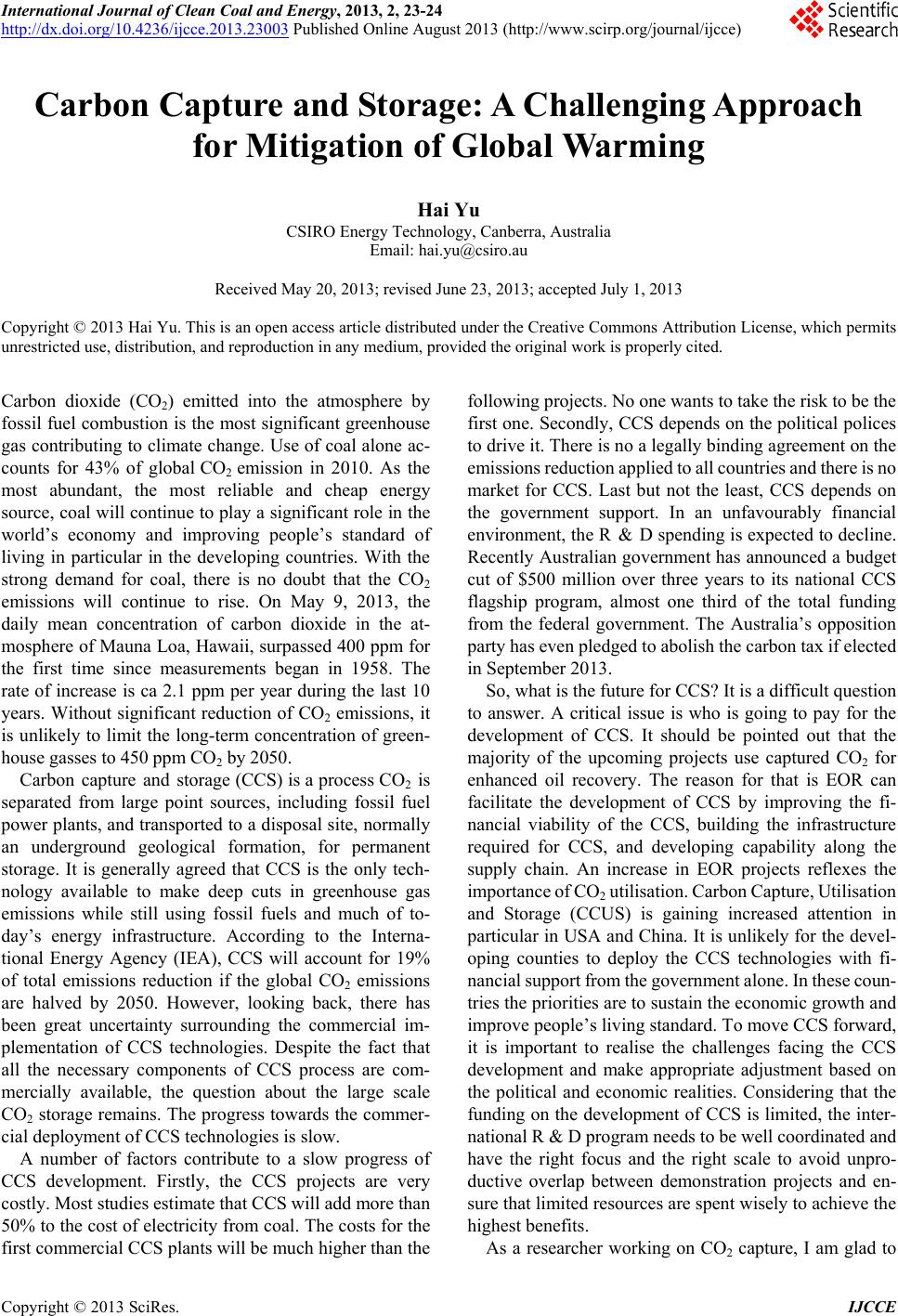Paper Menu >>
Journal Menu >>
 International Journal of Clean Coal and Energy, 2013, 2, 23-24 http://dx.doi.org/10.4236/ijcce.2013.23003 Published Online August 2013 (http://www.scirp.org/journal/ijcce) Carbon Capture and Storage: A Challenging Approach for Mitigation of Gl obal Warming Hai Yu CSIRO Energy Technology, Canberra, Australia Email: hai.yu@csiro.au Received May 20, 2013; revised June 23, 2013; accepted July 1, 2013 Copyright © 2013 Hai Yu. This is an open access article distributed under the Creative Commons Attribution License, which permits unrestricted use, distri bu ti on, and reproduction in any medium, provided the original work is properly cited. Carbon dioxide (CO2) emitted into the atmosphere by fossil fuel combustion is the most significant greenhouse gas contributing to climate change. Use of coal alone ac- counts for 43% of global CO2 emission in 2010. As the most abundant, the most reliable and cheap energy source, coal will continue to play a significant ro le in the world’s economy and improving people’s standard of living in particular in the developing countries. With the strong demand for coal, there is no doubt that the CO2 emissions will continue to rise. On May 9, 2013, the daily mean concentration of carbon dioxide in the at- mosphere of Mauna Loa, Hawaii, surpassed 400 ppm for the first time since measurements began in 1958. The rate of increase is ca 2.1 ppm per year during the last 10 years. Without significant reduction of CO2 emissions, it is unlikely to limit the long-term concentration of green- house gasses to 450 ppm CO2 by 2050. Carbon capture and storage (CCS) is a process CO2 is separated from large point sources, including fossil fuel power plants, and transported to a disposal site, normally an underground geological formation, for permanent storage. It is generally agreed that CCS is the only tech- nology available to make deep cuts in greenhouse gas emissions while still using fossil fuels and much of to- day’s energy infrastructure. According to the Interna- tional Energy Agency (IEA), CCS will account for 19% of total emissions reduction if the global CO2 emissions are halved by 2050. However, looking back, there has been great uncertainty surrounding the commercial im- plementation of CCS technologies. Despite the fact that all the necessary components of CCS process are com- mercially available, the question about the large scale CO2 storage remains. The progress towards the commer- cial deployment of CCS technologies is slow. A number of factors contribute to a slow progress of CCS development. Firstly, the CCS projects are very costly. Most studies estimate that CCS will add more than 50% to the cost of electricity from coal. The costs for the first commercial CCS plants will be much higher than the following projects. No one wants to take the risk to be the first one. Secondly, CCS depends on the political polices to drive it. There is no a lega lly binding agree ment on the emissions reduction applied to all countries and there is no market for CCS. Last but not the least, CCS depends on the government support. In an unfavourably financial environment, the R & D spending is expected to decline. Recently Australian government has announced a budget cut of $500 million over three years to its national CCS flagship program, almost one third of the total funding from the federal government. The Australia’s opposition party has even pledged to abolish the ca rbon tax if elected in September 2013. So, what is the future for CCS? It is a difficult questio n to answer. A critical issue is who is going to pay for the development of CCS. It should be pointed out that the majority of the upcoming projects use captured CO2 for enhanced oil recovery. The reason for that is EOR can facilitate the development of CCS by improving the fi- nancial viability of the CCS, building the infrastructure required for CCS, and developing capability along the supply chain. An increase in EOR projects reflexes the importance of CO2 utilisation. Carbon Capture, Utilisation and Storage (CCUS) is gaining increased attention in particular in USA and China. It is unlik ely for the devel- oping counties to deploy the CCS technologies with fi- nancial support from the governm ent alone. In these coun- tries the priorities are to sustain the economic growth and improve people’s living standard. To move CCS forward, it is important to realise the challenges facing the CCS development and make appropriate adjustment based on the political and economic realities. Considering that the funding on the development of CCS is limited, the inter- national R & D p r og ram needs to be well c o or di nat ed and have the right focus and the right scale to avoid unpro- ductive overlap between demonstration projects and en- sure that limited resources are sp en t wisely to achiev e th e highest benefits. As a researcher working on CO2 capture, I am glad to C opyright © 2013 SciRes. IJCCE  H. YU 24 see the increasing number of papers in CCS published in the international journals and more and more submissions come from developing countries. From a research point of view, I think it is important to continue research to further reduce the cost s for CO2 ca pture a nd risks ass ociated with CO2 storage. It is also important to explore opportunities to utilise the captured CO2 to improve the economic vi- ability of the CCS technologies. The path of technological developm ent has nev er been easy and straigh tforward. We may face a few years of slow progress but once the de- monstration projects get underway, this will regenerate the interest in CCS or CCUS as a global mitigation option. Copyright © 2013 SciRes. IJCCE |

